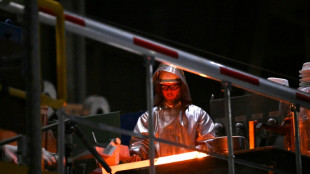
-
 Ecuador president unharmed after apparent gun attack on motorcade
Ecuador president unharmed after apparent gun attack on motorcade
-
Lyon exact revenge on Arsenal, Barca thrash Bayern in women's Champions League

-
 Trump says 'real chance' to end Gaza war as Israel marks attacks anniversary
Trump says 'real chance' to end Gaza war as Israel marks attacks anniversary
-
Gerrard brands failed England generation 'egotistical losers'

-
 NFL fines Cowboys owner Jones $250,000 over gesture to fans
NFL fines Cowboys owner Jones $250,000 over gesture to fans
-
Bengals sign veteran quarterback Flacco after Burrow injury

-
 New prime minister inspires little hope in protest-hit Madagascar
New prime minister inspires little hope in protest-hit Madagascar
-
Is Trump planning something big against Venezuela's Maduro?

-
 EU wants to crack down on 'conversion therapy'
EU wants to crack down on 'conversion therapy'
-
French sex offender Pelicot says man who abused ex-wife knew she was asleep

-
 Trump says 'real chance' to end Gaza war as Israel marks Oct 7 anniversary
Trump says 'real chance' to end Gaza war as Israel marks Oct 7 anniversary
-
UK prosecutors to appeal dropped 'terrorism' case against Kneecap rapper

-
 Spain, Inter Miami star Alba retiring at end of season
Spain, Inter Miami star Alba retiring at end of season
-
EU targets foreign steel to rescue struggling sector

-
 Trump talks up Canada deal chances with visiting PM
Trump talks up Canada deal chances with visiting PM
-
Knight rides her luck as England survive Bangladesh scare

-
 Pro-Gaza protests flare in UK on anniversary of Hamas attack
Pro-Gaza protests flare in UK on anniversary of Hamas attack
-
Top rugby unions warn players against joining rebel R360 competition

-
 Outcast Willis 'not overthinking' England absence despite Top 14 clean sweep
Outcast Willis 'not overthinking' England absence despite Top 14 clean sweep
-
Trump says 'real chance' of Gaza peace deal

-
 Macron urged to quit to end France political crisis
Macron urged to quit to end France political crisis
-
No.1 Scheffler seeks three-peat at World Challenge

-
 Canadian PM visits Trump in bid to ease tariffs
Canadian PM visits Trump in bid to ease tariffs
-
Stocks falter, gold shines as traders weigh political turmoil

-
 Senators accuse US attorney general of politicizing justice
Senators accuse US attorney general of politicizing justice
-
LeBron's 'decision of all decisions' a PR stunt

-
 Observing quantum weirdness in our world: Nobel physics explained
Observing quantum weirdness in our world: Nobel physics explained
-
WTO hikes 2025 trade growth outlook but tariffs to bite in 2026

-
 US Supreme Court hears challenge to 'conversion therapy' ban for minors
US Supreme Court hears challenge to 'conversion therapy' ban for minors
-
Italy's Gattuso expresses Gaza heartache ahead of World Cup qualifier with Israel

-
 EU targets foreign steel to shield struggling sector
EU targets foreign steel to shield struggling sector
-
Djokovic vanquishes exhaustion to push through to Shanghai quarterfinals

-
 Stocks, gold rise as investors weigh AI boom, political turmoil
Stocks, gold rise as investors weigh AI boom, political turmoil
-
Swiatek coasts through Wuhan debut while heat wilts players

-
 Denmark's Rune calls for heat rule at Shanghai Masters
Denmark's Rune calls for heat rule at Shanghai Masters
-
Japanese football official sentenced for viewing child sexual abuse images

-
 'Veggie burgers' face grilling in EU parliament
'Veggie burgers' face grilling in EU parliament
-
Trio wins physics Nobel for quantum mechanical tunnelling

-
 Two years after Hamas attack, Israelis mourn at Nova massacre site
Two years after Hamas attack, Israelis mourn at Nova massacre site
-
German factory orders drop in new blow to Merz

-
 Man City star Stones considered retiring after injury woes
Man City star Stones considered retiring after injury woes
-
Kane could extend Bayern stay as interest in Premier League cools

-
 Renewables overtake coal but growth slows: reports
Renewables overtake coal but growth slows: reports
-
Extreme rains hit India's premier Darjeeling tea estates

-
 Raducanu retires from opening match in Wuhan heat with dizziness
Raducanu retires from opening match in Wuhan heat with dizziness
-
UK's Starmer condemns pro-Palestinian protests on Oct 7 anniversary

-
 Tokyo stocks hit new record as markets extend global rally
Tokyo stocks hit new record as markets extend global rally
-
Japan's Takaichi eyes expanding coalition, reports say

-
 Canadian PM to visit White House to talk tariffs
Canadian PM to visit White House to talk tariffs
-
Indonesia school collapse toll hits 67 as search ends


Astronomers reveal evidence of universe's 'background hum'
Astronomers across the world announced on Thursday that they have found the first evidence of a long-theorised form of gravitational waves that create a "background hum" rumbling throughout the universe.
The breakthrough -- made by hundreds of scientists using radio telescopes in North America, Europe, China, India and Australia after years of work -- was hailed as a major milestone that opens a new window into the universe.
First predicted by Albert Einstein more than a century ago, gravitational waves are ripples in the fabric of the universe that travel through everything at the speed of light almost entirely unimpeded.
Their existence was not confirmed until 2015, when the US and Italian observatories detected the first gravitational waves created by two black holes colliding.
These "high-frequency" waves were the result of a single violent event that sends a strong, short burst rippling towards Earth.
But for decades scientists have been searching for low-frequency gravitational waves, thought to be constantly rolling through space like background noise.
Joining forces under the banner of the International Pulsar Timing Array consortium, scientists working at gravitational wave detectors on several continents revealed on Thursday they have finally found strong evidence of these background waves.
"We now know that the universe is awash with gravitational waves," Michael Keith of the European Pulsar Timing Array told AFP.
- Using dead stars as clocks -
As gravitational waves travel through space, they very subtly squeeze and stretch everything they pass through.
To find evidence of this squeezing and stretching at low frequencies, astronomers looked at pulsars, the dead cores of stars that exploded in a supernova.
Some spin hundreds of times a second, flashing beams of radio waves at extremely regular intervals, like cosmic lighthouses.
This means they can act as "a very, very precise clock," Keith said.
For the new research, radio telescopes around the world were aimed at a total of 115 pulsars throughout the Milky Way.
Scientists then measured the incredibly small differences in the timing of the pulses, searching for telltale signs of gravitational waves.
French astrophysicist Antoine Petiteau said they were able to "detect changes of less than one millionth of a second across more than 20 years".
Maura McLaughlin of the US Pulsar Search Collaboratory programme said they were "awestruck" after first seeing evidence of the waves in 2020.
It was "really a magical moment," she told a press conference.
The early evidence was consistent with Einstein's theory of relativity and science's current understanding of the universe, the scientists said.
But they emphasised they have not yet definitively "detected" the waves, because they have not reached the gold-standard five sigma level of certainty. Five sigma indicates that there is a one-in-a-million chance of something being a statistical fluke.
"We're frustratingly just shy of the mark," Keith said, adding that there was a 99-percent probability that the evidence points to gravitational waves.
Each country or group in the consortium published their research separately in a range of journals.
Steve Taylor, chair of North America's NANOGrav gravitational wave observatory, said that once all the data was combined, the five sigma mark could be reached in a year or two.
- 'Like sitting in a noisy restaurant' -
The leading theory is that the waves are coming from pairs of supermassive black holes sitting at the centre of galaxies that are slowly merging.
Unlike those that caused the previously detected gravitational waves, these black holes are almost unimaginably huge -- sometimes billions of times bigger than the Sun.
Daniel Reardon, a member of Australia's Parkes Pulsar Timing Array, told AFP that -- if confirmed -- the waves would be "the sum of all of the supermassive black hole binary systems whirling around each other at the cores of galaxies everywhere in the universe".
Keith said the "background hum of all these black holes" was "like sitting in a noisy restaurant and hearing all these people talking".
Another theory is that the gravitational waves could be from the rapid expansion that came within a second after the Big Bang, a period called cosmic inflation that is hidden from the view of scientists.
Keith said the galaxies between Earth and the Big Bang were likely "drowning out" such waves.
But in the future, low-frequency gravitational waves could reveal more about this early expansion and possibly shed light on the mystery of dark matter, the scientists said.
It could also help them understand more about how black holes and galaxies form and evolve.
O.Lorenz--BTB



